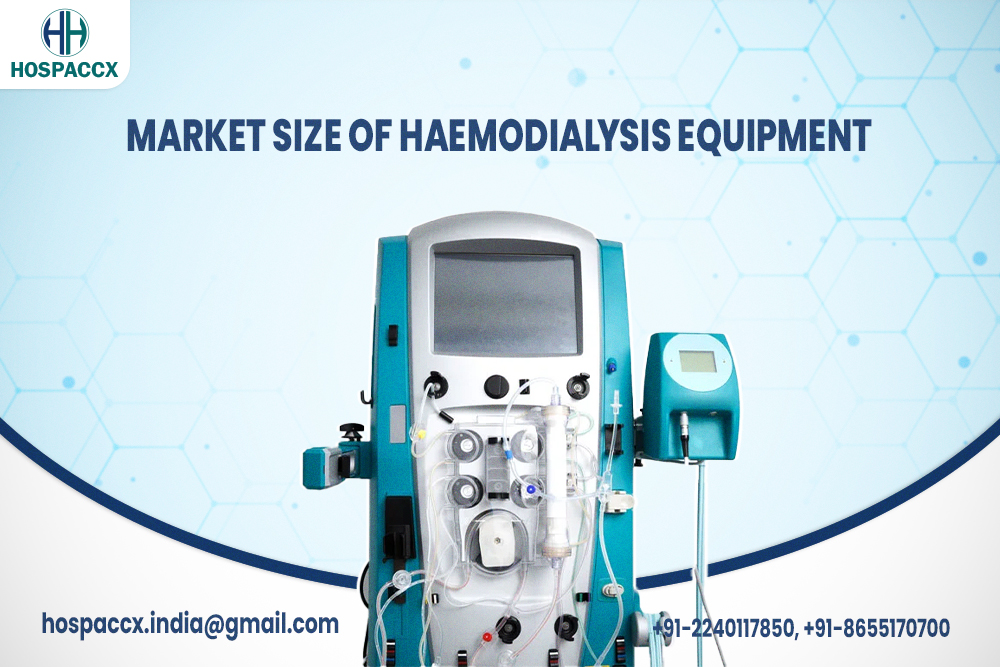MARKET SIZE OF HAEMODIALYSIS EQUIPMENT’S
Are you looking to acquire Haemodialysis Equipment for your healthcare organization? Searching for a suitable market information for Haemodialysis Equipment’s? Information related to demand and supply of Haemodialysis Equipment. In this article, Hospaccx Healthcare Consultancy has mapped all the information related to the medical linear accelerator.
INTRODUCTION
Haemodialysis is a process of purifying the blood of a person whose kidneys are not working normally. This type of dialysis achieves the extracorporeal removal of waste products such as creatinine and urea and free water from the blood when the kidneys are in a state of kidney failure.
Haemodialysis cleanses the blood mainly by diffusion technique. Fluid removal occurs via a hydrostatic pressure gradient across the dialyzer membrane, which is generated by the dialysis machine.
When is dialysis needed? Where is dialysis done?
When kidneys no longer remove enough wastes and fluid from the blood. This usually happens only 10 to 15 percent of your kidney function left. Haemodialysis can be done in a hospital, in a dialysis center or at home.
Types of Haemodialysis apparatus:
- Dialyzer;
- Dialysis solution (dialysate)
- Tubing for the transport of blood and dialysis solution; and
- Haemodialysis machine to power
Types of Haemodialysis technique
- Dialyzer synthetic tubing: Carries blood from the arteriovenous access to the dialyzer (via dialyzer inlet), whereas a venous line simultaneously carries dialyzed blood (via dialyzer outlet) back to the patient.
- Dialyzer machine: Includes a blood pump to move blood between patient and dialyzer, a delivery system to transport dialysis solution, and monitoring devices. Pressure monitors, guard against excessive suction of blood from, and excessive resistance of blood return to, the patient’s vascular access site. Additional quintessential monitoring devices in the machine include an air detector and air trap device to prevent air from entering the circuit, solute concentrate measurement device, temperature sensor, and dialysate urea sensor.
- Hemodiafiltration (HDF): This blood purification method that incorporates a convective, adsorptive-type driving force (with a specially designed filter for more solute removal) in addition to diffusional type. The transmembrane pressure (maintained by a suction pump) causes the patient’s plasma to flow across the membrane, pulling large-molecular-weight uremic toxins across the membrane.
A single haemodialysis session in India with a new dialyzer can cost between 1800 and 3400 (versus 500 dollars in the USA), while a reuse session would cost between 1600 to 2700. The cost of single use hemodiafiltration would range between 3200 and 4500. If there are no-cost constraints, HDF is a preferred option to conventional HD and most big dialysis units in India are progressively increasing the numbers of HDF machines (Nipro/Fresenius).
FACTORS FOR MARKET GROWTH
- Increase in incidence of hypertension and diabetes.
- Rise in number of end stage renal disorder (ESRD) patients.
- Shortage in availability of kidneys for transplants are the key factors that augment the growth of the market.
MARKET TRENDS
The global kidney dialysis equipment market is touted to accumulate USD 16.5 billion at a stupendous 5.7 percent CAGR (compound annual growth rate) during the assessment period (2018–2023).
India dialysis market was valued at USD 3.1 billion in 2017.
As kidney transplant is still an elusive procedure in India, most patients are put on hemodialysis.
Market challenges
- Consistent innovation in the dialysis equipment market is leading to the creation of complex systems that patients and clinicians are having trouble getting accustomed to. The greatest challenge is the lack of instructive training and ease of accessibility of the equipment.
- Hike in import duty: The government recently announced a hike in the import duty which will negate any benefits of duty exemptions. This is because 70 percent of parts of complete dialysis are still imported in India.
- Operational constraints: Equipment such as Reverse Osmosis (RO) facilities, accessory equipment, dialysis beds, continuous supply of water, and availability of trained technicians and nurses are of scarce supply. Even though duty exemptions will make it easier for district hospitals to get dialysis equipment, they will also require supporting equipment to effectively treat kidney patients.
MARKET SEGMENTATION
Based on type
- Conventional (3 times per week)
- Daily (6 days a week)
- Nocturnal (3-6 nights per week)
Based on product and service
- Equipment
- Consumable
- Drug
- Service
Based on end user
- In-center dialysis
- Home dialysis
KEY PLAYERS IN INDIAN DIALYSIS MARKET
Currently, some players in the Indian dialysis equipment market include:
- Fresenius
- B Braun
- Baxter-Gambro
- Nipro.
MARKET DRIVERS
The driving force for the ever-increasing demand for dialysis equipment are:
- The exponential rate of growth of non-communicable diseases like diabetes, obesity, and hypertension
- The continuous increase in the geriatric population.
CONCLUSION
At present, business in the Indian dialysis market is valued at USD 50.0 billion and is expected to grow further. One of the latest developments in the market is the proposed launch of a portable dialysis system by Medtronic. Such a machine will be easily transportable in rural India and will require less water, less treatment, and less technician expertise.
If you need any support regarding procurement, purchasing, investing in Haemodialysis Equipment for your healthcare organization, you can contact us: Hospaccx healthcare business consulting Pvt. Ltd on you can visit our website hospaccxconsulting.com
Related Team Members










